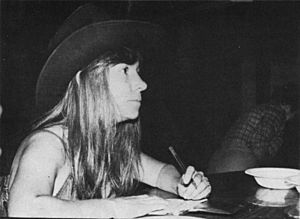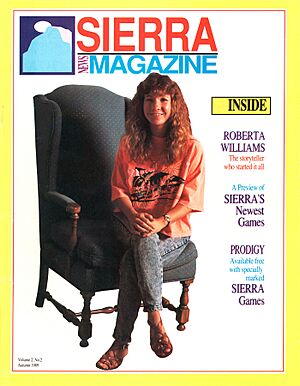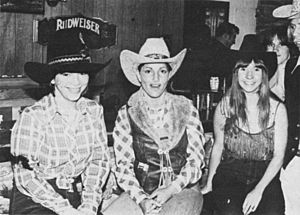Roberta Williams facts for kids
Quick facts for kids
Roberta Williams
|
|
|---|---|

Roberta Williams in 2022
|
|
| Born |
Roberta Lynn Heuer
February 16, 1953 Los Angeles, California, U.S.
|
| Occupation | Video game designer, writer |
| Known for |
|
| Spouse(s) |
Ken Williams
(m. 1972) |
| Children | 2 |
Roberta Lynn Williams (born February 16, 1953) is an American video game designer and writer. She is famous for creating many popular computer games. Roberta co-founded a company called Sierra On-Line with her husband, game developer Ken Williams.
In 1980, her first game, Mystery House, became a success. It was special because it was the first adventure game to include graphics. Roberta is also well-known for making and continuing the King's Quest game series. She also designed the game Phantasmagoria in 1995, which used real actors in videos.
Sierra was bought by another company in 1996. Roberta took a short break but later returned to game design. She left the game industry in 1999 after the game King's Quest: Mask of Eternity was released. After leaving, she focused on traveling and writing historical stories. In 2021, she released her historical novel, Farewell to Tara. She returned to game development soon after, creating a new version of the classic game Colossal Cave Adventure. This new game, called Colossal Cave, was released in January 2023.
Many people in the video game world consider Roberta Williams one of the best and most important creators. She helped start Sierra, pioneered graphic adventure games, and made the King's Quest series. Some even call her the "Queen of adventure games." She has received important awards, like the Industry Icon Award from The Game Awards and the Pioneer Award at the Game Developers Choice Awards.
Contents
Early Life and Career Beginnings
Roberta Heuer was born in Los Angeles. She grew up in the countryside of Southern California. Her father worked as an agricultural inspector. Roberta was a shy child but had a very active imagination. She often made up fairy-tale adventure stories for her family. She would imagine exciting situations, which she called her "movies."
She met her future husband, Ken Williams, when they were teenagers. They started dating and later married in 1972. Roberta worked as a clerk and later as a computer programmer. By 1979, Roberta and Ken had two children. Ken worked as a computer programmer. They wanted to move out of Los Angeles and live in the woods. Roberta bought an Apple II computer for their family. She loved playing text adventure games on it.
Roberta's Game Design Journey
Creating Early Graphic Adventure Games (1979–1983)
Around 1979, Roberta Williams loved playing text adventure games, especially Colossal Cave Adventure. She had an idea for a new kind of video game. She was inspired by Agatha Christie's story And Then There Were None and the board game Clue. Roberta convinced her husband, Ken, to help her. She would create the story and pictures, and he would handle the computer programming.
Roberta drew the pictures using her Apple II computer and a special device called a Versawriter. Ken had to write a program to read these images. He managed to fit almost seventy pictures onto one disk. The game they created was Mystery House. It was an adventure game with black and white graphics for the Apple II.
Mystery House was released in 1980. It was sold by mail order and advertised in computer magazines. The game quickly sold ten thousand copies. Roberta herself packed the game disks and helped players with puzzles over the phone. Ken started delivering copies of the game to computer stores. He quit his consulting job, hoping to focus on their new game business.
Later that year, they released Wizard and the Princess. This game had better color graphics. It sold 60,000 copies, which led them to hire more people. Their company, On-Line Systems, changed its main focus from consulting to making games. Roberta's ideas grew, and she designed Time Zone, a huge time-traveling game released on twelve disks in 1982.
Around this time, Roberta's parents moved to Oakhurst, California. Roberta wanted to move closer to them. As their company grew, they were able to move On-Line Systems from Simi Valley, California to Coarsegold. They also changed their company name to Sierra On-Line, named after the nearby Sierra Nevada mountains.
In just two years, Sierra grew to almost a hundred employees. The company made $10 million in revenue. Sierra's success attracted investors. Around this time, Jim Henson asked Ken Williams to create a game based on the movie The Dark Crystal. Roberta was very excited about this project. She believed video games were as important as movies for entertainment. She designed much of the game on paper, and it was released in 1983. This popular game brought a lot of attention to Sierra. Roberta hoped that the entertainment industry would see the value of games and the artists who made them.
The King's Quest Success (1983–1994)
By 1983, Sierra's new investors wanted the company to make video game cartridges for systems like the Atari. However, the video game industry soon faced a big problem called the crash of 1983. Sierra's board of directors considered merging with an educational software company. Roberta strongly disagreed with this idea, saying, "These guys are a joke." The merger did not happen. Sierra had to reduce its staff to 30 employees. The Williams family even mortgaged their home to pay their remaining workers.
Sierra had a good relationship with IBM. Wizard and the Princess was one of the first games released for the IBM PC. During Sierra's financial troubles, IBM offered to invest in the company. IBM wanted a game that could show off their new IBM PCjr computer. Roberta wanted to create a fully animated adventure game with a pseudo-3D world. This led to the 1984 release of King's Quest. It was a mix of common fairy tales that players could experience directly.
Even though the PCjr computer was not very successful, King's Quest was released on many other platforms and quickly became a bestseller. The game was seen as revolutionary because players could move their character in front of, behind, or over objects on the screen. It was also one of the first computer games to support 16 colors, setting a new standard for future graphic adventure games.
Roberta continued to design the King's Quest series. These games became known for their unique stories and increasingly advanced graphics. The 1986 game, King's Quest III: To Heir is Human, was bigger and longer than previous games. It even made it onto Time magazine's list of 50 Best Video Games of All Time.
When King's Quest IV: The Perils of Rosella was released in 1988, it was one of the first games to use a sound card and a mouse. It was also one of the first games to feature a female main character. Some people worried this might stop men from playing, but the game was even more successful. A survey showed that most men didn't mind playing as a female character, and many female players preferred it. King's Quest IV helped bring more women into computer gaming. It is considered one of the most influential video games ever.
Williams also designed other games, like the educational title Mixed-Up Mother Goose. This game sold over 500,000 copies. In 1989, Williams released another mystery adventure game called The Colonel's Bequest. This game improved on her original Mystery House ideas with better graphics. It was still rare for a game to have a female main character.
The 1990 release of King's Quest V was the first game to use an icon-based interface, which was a new design idea. This game won several awards and was listed as one of the greatest games of all time. By the early 1990s, Sierra was a public company, making $100 million per year. Williams also worked on King's Quest VI, released in 1992, which was recognized as one of the best adventure games. By the mid-1990s, Williams was Sierra's most popular game designer. The King's Quest series is still remembered as the only video game series created and continued by a female designer.
Later Games and Leaving the Industry (1995–1999)
Williams tried something new by designing Phantasmagoria, a realistic horror adventure game. She was a big fan of novels by Stephen King. She wondered if she could make a truly scary video game. She believed it needed real actors to be frightening. So, the game was made entirely with full-motion video. The game cost $4 million to make and had a team of almost two hundred people.
Phantasmagoria was designed for adults and was marketed as an interactive film. It was released on seven CD-ROMs. Even though some critics had mixed feelings, it was one of the most successful adventure games and Sierra's bestselling game. It sold over a million copies in 1995. Williams says this game is her favorite achievement.
In 1996, Sierra was sold to CUC International for over a billion dollars. Roberta had not wanted the deal to happen. Many Sierra employees felt something was wrong with CUC's finances. Roberta eventually agreed because the deal was too good to refuse. The new company, CUC, changed how Sierra was managed. Ken Williams left his role at Sierra. Roberta Williams took a break from the game industry. During this time, the company released The Roberta Williams Anthology, a collection of 14 of her games.
Roberta Williams returned to game development in early 1997 to work on King's Quest: Mask of Eternity. She wanted to bring back more interactive elements and use new 3D graphics technology. Sierra had changed a lot. The new management wanted to add parts from popular role-playing games like Diablo. This was different from the traditional adventure game style. Roberta felt she was losing control. She also suspected CUC of financial fraud.
Worried about the company's future, she and Ken sold their stock. Ken resigned at the end of 1997, and Roberta stayed to finish Mask of Eternity. The game was released in 1998 but was not very successful. This led to more layoffs. Sierra was then sold to Vivendi. That year, CUC was found guilty of financial fraud. The decline of Sierra made Roberta very sad, and she left the company in 1999. By the 2000s, Sierra's games were owned by Activision Blizzard.
Life After Sierra
After King's Quest: Mask of Eternity was released, Roberta Williams said she was taking a break from the game industry in 1999. Actually, she and Ken had signed an agreement that stopped them from working in the game industry for five years. Ken said that by the time the five years were over, they had moved on to other things. This ended Roberta's game career after 18 years and 20 games. She stayed out of the public eye and rarely spoke to the press.
In a rare interview in 2006, she said her greatest achievement was Phantasmagoria. She also expressed her love for the King's Quest series. Williams said her role as a game designer was in the past. She was focused on writing a historical novel. She also enjoyed traveling and sailing with her husband.
In 2011, a website reported that she had returned as a design consultant for a social network game called Odd Manor for Facebook. In 2012, other game developers tried to convince the Williamses to return to the game industry. Activision hired Telltale Games to make a new King's Quest game. Williams did not work on the game but offered some advice. The game was later canceled in 2013. Activision tried to bring back the Sierra brand in 2014. The developers of the new game, King's Quest: A Knight to Remember, said they talked with Roberta Williams.
In 2019, the Vancouver Film School announced a scholarship named The Roberta Williams Women in Game Design Scholarship. In 2021, Williams published her first novel, Farewell to Tara. It is set in Ireland in the mid-1800s during the time of the Great Famine.
Roberta and Ken announced in June 2021 that they planned to return to game development. In an interview that same year, she wondered if an older game designer could successfully return after a long break. In 2022, their new studio, Cygnus Entertainment, announced they were making a remake of Colossal Cave Adventure. It was titled Colossal Cave 3D Adventure. Roberta explained that this pioneering game from the 1970s had inspired her career. She was excited to re-imagine it as an interactive 3D experience.
Roberta Williams' Impact and Awards
In 1995, Next Generation magazine listed Roberta Williams among the 75 most powerful people in the game industry. Computer Gaming World also ranked her tenth on their 1997 list of the most influential people in computer gaming. They praised her impact on adventure game design. GameSpot ranked her tenth in 1999 for "pushing the envelope of graphic adventures." They noted her efforts to create games that appealed to a wider audience, especially women. In 2009, IGN included both Roberta and Ken in their list of top game creators. They highlighted their role in starting Sierra, which made many popular adventure games.
Computer Gaming World added Roberta Williams to their Hall of Fame in 2011. Both Roberta and Ken received an Industry Icon Award at The Game Awards in 2014. She also won the Pioneer Award at the 20th Game Developers Choice Awards in March 2020. This was for her important work in graphic adventure games with Mystery House and for creating the King's Quest series.
Ken Williams has described Roberta as a perfectionist. He said she is "extremely smart, intuitive and usually right." Ars Technica called her "one of the more iconic figures in adventure gaming." They noted she was one of the first well-known female game designers. Smithsonian magazine recognized her as a pioneer of graphic adventure games. She created the first home computer game to include graphics. Many publications have called her "the Queen of adventure games."
Roberta Williams has also inspired characters and artwork in other games. She posed for the cover of the game Softporn Adventure. She also posed with her children as Mother Goose for the cover of Mixed-Up Mother Goose. She even makes a small appearance in Leisure Suit Larry 3. Ellie Williams, a character in The Last of Us video game series, is named after Ken and Roberta. She also inspired the character Cameron Howe in the TV show Halt and Catch Fire. The Williams family donated many of their game design materials to the International Center for the History of Electronic Games.
Games Designed by Roberta Williams
- Mystery House (1980)
- Wizard and the Princess (1980)
- Mission Asteroid (1981)
- Time Zone (1982)
- The Dark Crystal (1983)
- King's Quest I: Quest for the Crown (1984)
- Mickey's Space Adventure (1984)
- King's Quest II: Romancing the Throne (1985)
- King's Quest III: To Heir Is Human (1986)
- Mixed-Up Mother Goose (1987)
- King's Quest IV: The Perils of Rosella (1988)
- Laura Bow: The Colonel's Bequest (1989)
- King's Quest V: Absence Makes the Heart Go Yonder! (1990)
- King's Quest 1: Quest for the Crown (Remake) (1990)
- Mixed-Up Mother Goose Multimedia (1990)
- Laura Bow in The Dagger of Amon Ra (1992)
- King's Quest VI: Heir Today, Gone Tomorrow (1992)
- King's Quest VII: The Princeless Bride (1994)
- Mixed-Up Mother Goose Deluxe (1995)
- Phantasmagoria (1995)
- Shivers (1995)
- King's Quest: Mask of Eternity (1998)
- Odd Manor (2014)
- Colossal Cave - Remake (2023)
Novels Written by Roberta Williams
- Farewell to Tara (2021)
See also
 In Spanish: Roberta Williams para niños
In Spanish: Roberta Williams para niños







